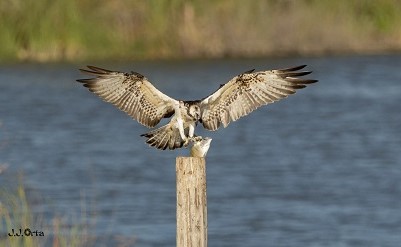- Since its restoration in 2001, thanks to the work of Fundación Cepsa and the Regional Government of Andalusia, the lagoon’s biodiversity has grown every year
- In these summer months, osprey, a species classified as 'vulnerable,' can be found at the lake
- The presence of this species is an indicator of the quality of the lake's ecosystem
This commitment to sustainability is a part of the essence of Cepsa and its Foundation, which want to build a better world for its customers, employees, and the environments in which it operates, such as Andalusia. These types of actions should not be one-off, but part of a realistic, effective, committed, and just plan, with long-term goals. An example of this commitment, framed by SDGs No. 7 (Affordable and clean energy) and No. 15 (Life of Terrestrial Ecosystems), is the project undertaken by Cepsa and its Foundation in Laguna Primera de Palos, a natural area of great ecological value. This project represents an environmental milestone in Spain, and is very much in line with the UN Decade on Ecosystem Restoration, which aims to prevent, halt, and reverse the degradation of ecosystems.
The Primera de Palos lake is a rich natural space. Since the restoration process was completed in June 2021, its biodiversity has grown every year thanks to a rigorous maintenance, research, and public use program developed by Fundación Cepsa and the Department of Sustainability, Environment and Blue Economy of the Regional Government of Andalusia.
In these summer weeks, the osprey, together with the otter, the kings of the lake, once again demonstrate their importance to biodiversity in southern Huelva province. The osprey (Pandion haliaetus) is a threatened species listed as “Vulnerable.” In the 1980s it stopped breeding in Andalusia, as well as on the rest of the Iberian peninsula, with only a few pairs remaining in the Canary and Balearic Islands. However, thanks to the successful reintroduction project implemented by the Regional Government of Andalusia in 2003, based on the ‘hacking’ technique, several breeding pairs have already settled in the provinces of Cadiz and Huelva.
The first specimen observed in Laguna Primera de Palos appeared in October 2012, making frequent visits for four months. In 2013, as part of Fundación Cepsa's actions to improve biodiversity in Huelva, and in collaboration with the Department of Sustainability, Environment and Blue Economy (Regional Government of Andalusia), a perch was placed in the center of the lake. The osprey quickly took it as a look-out post and a place to consume its prey. Since then, sightings of the species have been increasing, and it can be spotted practically every month of the year.
Osprey feed exclusively on fish, for which it is very well adapted with its strong, scaled legs, long, curved talons that make it easier to grasp prey, and nasal valves that close during hunting dives. In the Laguna de Palos it has been observed feeding on marine species such as mullet(Mugil cephalus) and seabream (Diplodus sargus), which indicates that it feels safe in this area and it does not mind the extra effort of transporting prey from the sea.
In 2022, Fundación Cepsa carried out new improvement projects in the Palos Lagoon which included a series of habitat improvements and installing an artificial nest to encourage the ospreys that frequent this wetland to breed. The first specimens have already been observed perching on it, but it is a very sensitive species that may require several years to accept a new nest, so we will have to wait over the next few springs to see if this spot meets their needs.
The presence of this species is an indicator of the quality of the ecosystem in Palos Lake and contributes to its conservation in the region. With continued protection and conservation of its habitat and collaboration between organizations, the future of the osprey in Laguna de Palos appears to be taking a more favorable course. The presence of this unique bird of prey is a reminder of the importance of preserving and protecting our rich biodiversity and of our responsibility to do so.
Laguna Primera de Palos
This wetland, located close to Cepsa's facility in Palos de la Frontera, Huelva, is part of the Paraje Natural Lagunas de Palos y Las Madres, a natural area of great significance. It belongs to the Red Natura 2000 and it has been a Wetland of International Importance (Ramsar Area) since 2006, which promotes the conservation and wise use of these areas. One hundred and fifty-two bird species visit the lake, of which 61 are threatened.
From the start, Cepsa, together with the Regional Government of Andalusia, worked to create a project that would not be simply a clean-up of the land, but a comprehensive restoration, approaching it from a three-pronged perspective: ecological recovery, landscape restoration, and environmental awareness, which will allow for the future conservation of the space.
The initiative led by Fundación Cepsa has received important awards such as the Garrigues Walker-Expansión National Environmental Award and the Red Life and Caja Rural del Sur Foundation award.

